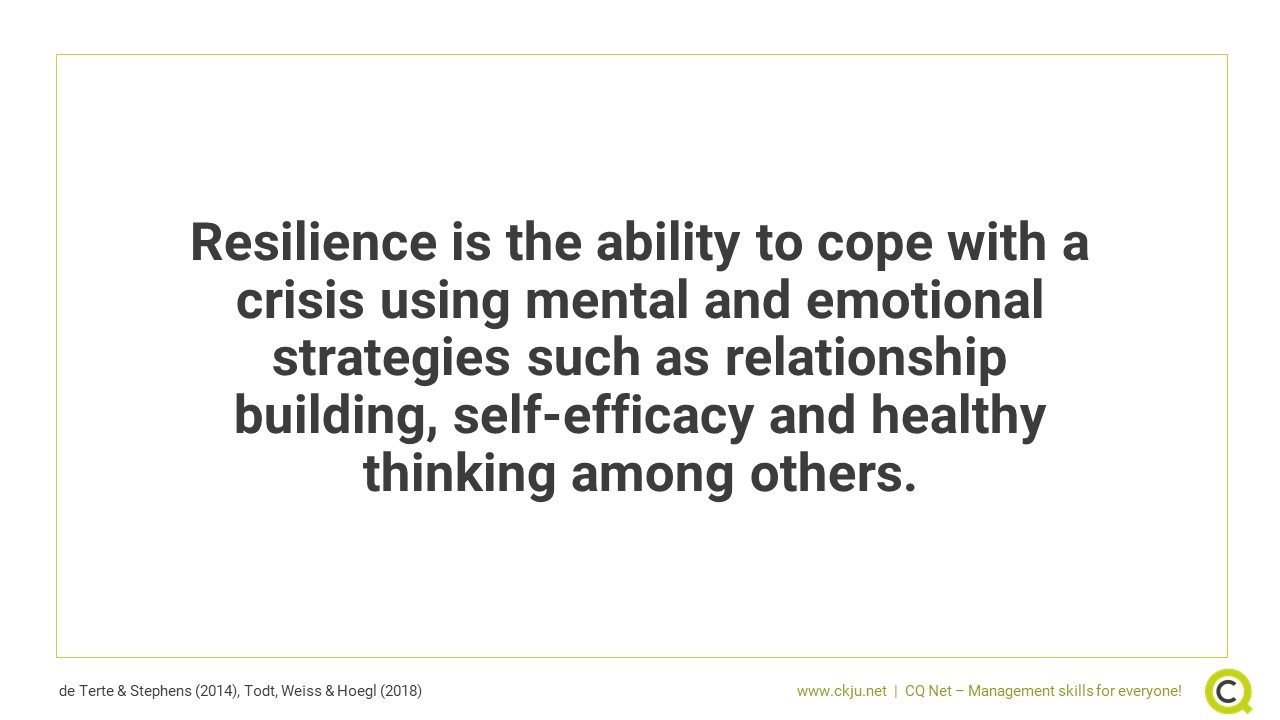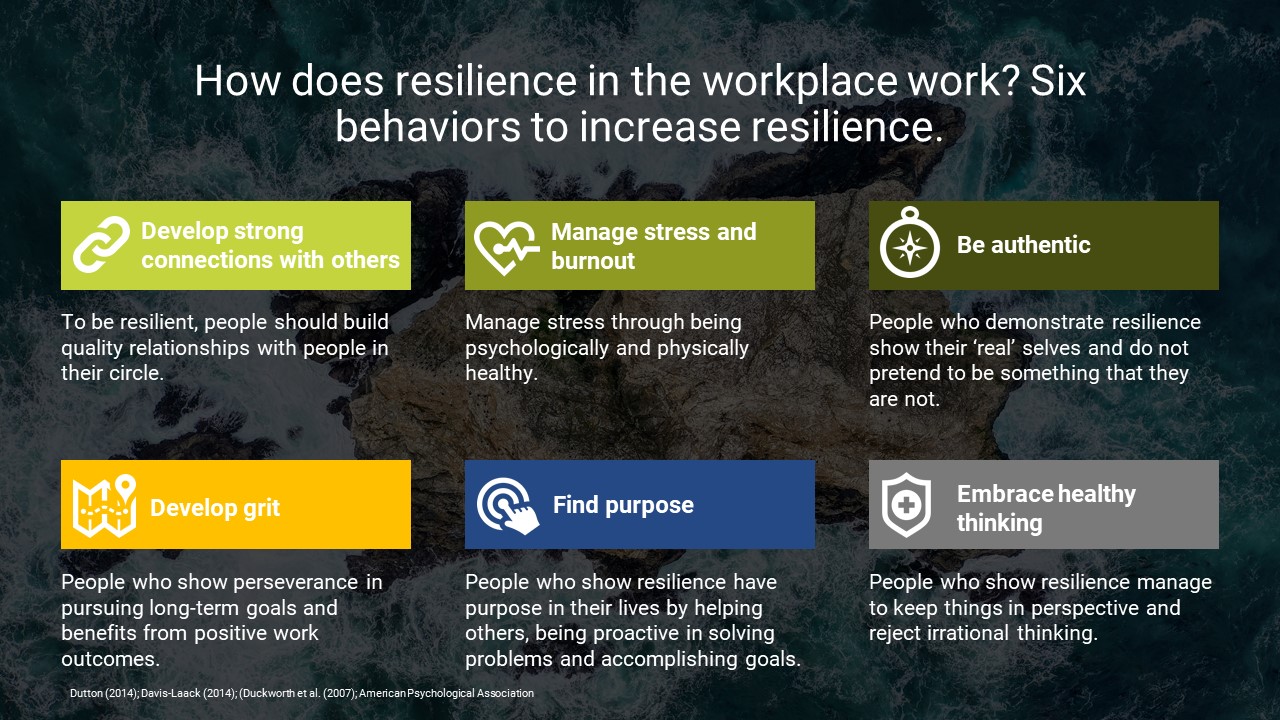- All Management Learning Resources
- Resilience

Why should you care about resilience in the workplace?
Rapid changes in technology and work have ushered in many potential stressors for employees. It is difficult to know how to deal with these changes and how to be effective at work. One way to manage pressures at work is through resilience. Being resilient can enable employees to cope well with a crisis particularly in highly stressful occupations (de Terte & Stephens, 2014). Distinct from the individual trait of resiliency, resilience is a set of behaviors so employees can be equipped with the knowledge and skills of resilience through training interventions (Zautra, Hall & Murray, 2010; King, Newman & Luthans, 2016).
Contents
- Why should you care about resilience in the workplace?
- What is resilience in the workplace?
- How does resilience in the workplace work?
- What are the benefits of resilience in the workplace?
- What are the shortcomings of resilience in the workplace?
- Resilience is key to bounce back quickly after a set-back or crisis
- Critical appraisal of resilience in the workplace: Solidity Rating 4
- Key recommendations for professionals
- References and further reading
What is resilience in the workplace?
Resilience is defined as the ability to cope with a crisis using mental and emotional strategies (de Terte & Stephens, 2014). Individuals who demonstrate resilience have emotional and behavioral capacities that ensure they remain calm during a crisis and to rebound quickly once the crisis is over. Moreover, despite being in a crisis they can move on without any long-term negative consequences. The concept of resilience has been examined in workplaces that have experienced setbacks or failure. In addition, resilience is important in workplaces that are involved in innovation, a highly uncertain context (Luthans, 2002).
The concept of resilience has been examined in workplaces that have experienced setbacks or failure. In addition, resilience is important in workplaces that are involved in innovation, a highly uncertain context (Luthans, 2002).
In the context of workplace innovation, the Innovator Resilience Potential (IRP) measures the potential for innovation after experiencing a set-back and consists of the following six dimensions (Todt, Weiss & Hoegl, 2018:
- self-efficacy,
- outcome expectancy,
- optimism,
- hope,
- self-esteem, and
- risk propensity.
Research on resilience in the workplace shows that it is related to a variety of workplace outcomes, including turnover intentions, organizational commitment, job satisfaction, and work engagement (Shin, Taylor & Seo, 2012’ Youssef & Luthans, 2007).
How does resilience in the workplace work?
Resilience in the workplace works when employees engage in the following behaviors:
Develop strong connections with others
To be resilient, employees should build quality relationships with people in their circle. These connections are not acquaintances but are connections built on a strong foundation. To build strong connections, it is important to communicate supportively, be an effective listener, build trust, and have moments of play (Dutton, 2014)
Manage stress and burnout
Manage stress through being psychologically and physically healthy. Taking care of your physical well-being through good nutrition, ample sleep, hydration, and exercise (American Psychological Association).
Be authentic
Employees who demonstrate resilience show their ‘real’ selves and do not pretend to be something that they are not. Rather than assuming a role, they display the best of their capabilities and are also courageous when they make mistakes. They are content to be vulnerable (Davis-Laack, 2014).
Develop grit
Employees who show resilience also have grit. An employee with grit shows perseverance in pursuing long-term goals and benefits from positive work outcomes, such as promotions and bonuses (Duckworth et al., 2007). One of the reasons grit is a positive enabler is because when you pursue difficult goals, you are more likely to experience setbacks and resilience increases grit and the ability to bounce back.
Find purpose
Employees who show resilience have purpose in their lives. They gain this in a variety of ways including helping others, being proactive in solving problems; accomplishing goals, and looking for opportunities that allow self-discovery (American Psychological Association).
Embrace healthy thinking
Employees who show resilience manage to keep things in perspective and reject irrational thinking such as blowing things into catastrophes or believing that nobody likes you. In addition, even when hit by a stressful event, employees who demonstrate resilience reinterpret the event and take advantage of the challenge. They also accept change, have hope for the future, yet are also able to learn from the past (American Psychological Association).
What are the benefits of resilience in the workplace?
Resilience in the workplace is associated with a set of benefits. We have a look at the most important ones in the following section.
Provides opportunities for training
Because resilience is a state-based factor within the workplace, professionals can develop training initiatives to teach the skills of resilience (King et al., 2016). In fact, personal growth training involving cognitive transformation can enable individuals to recognize new opportunities through dealing with adversity and a reevaluation of a traumatic experience that was threatening to one that allows for growth (Tebes, Irish, Puglisi-Vasquez, & Perkins, 2004)
Provides opportunities for relationships
Through building resilience, employees can build new relationships and strengthen existing ones (King et al., 2016). Executive coaching also works.
In an experimental study, 41 executives received 360-degree feedback, a half-day leadership working and four individual coaching sessions over a 10-week period. Compared to the control group, those who received the training and development, showed increases in resilience, and workplace well-being. The participants stated that they found the coaching increase their confidence and personal insight (Grant, Curtayne & Burton, 2009).
What are the shortcomings of resilience in the workplace?
As with every management tool, reslience has not just benefits but also some shortcomings you should be ware of. We will have a look at the most important ones in the following section.
Too much of a good thing
Overall, resilience is a positive quality and provides a useful set of skills for employees. However, there is a turning point whereby employees can possess too much resilience. This can lead to employees tolerating toxic environments such as an abusive supervisor because they have high levels of resilience and resist the urge to leave (Chamorro-Premuzic & Lusk, 2017).
Resilience can inhibit self-awareness
Many organizations believe that the ideal employee is a superhero, much like Superman, who is able to fly through crises and disasters. However, being a superhero can come with a price because it can limit self-awareness such as admitting being fearful of change or a potential crisis.
In fact, research suggests that overly confident leaders are unaware of their shortcomings yet also inflate their leadership capital so they resist challenges to fix their weaknesses (Chamorro-Premuzic & Lusk, 2017). In effect, too much resilience can lead to an unwillingness to change and even management derailment.
Resilience is key to bounce back quickly after a set-back or crisis
It is useful for employees to develop resilience, so they bounce back quickly after a set-back or crisis. Research shows that resilience is a malleable characteristic so employees can gain knowledge and skills to improve resilience.
Critical appraisal of resilience in the workplace: Solidity Rating 4
Based on the importance of resilience, this dossier is assigned a Level 4 rating (Based on a 1- 5 measurement scale). A level 4 is the second highest rating score for a dossier based on the importance of resilience in the workplace. Resilience can be very useful when professionals need strategies to deal with a crisis or setback.
Key recommendations for professionals
- Develop strong connections with others. Have quality and fewer relationships to build trust.
- Engage in exercise and healthy eating habits to reduce stress and burnout. This increases resilience.
- Be true to yourself and show your real self rather than trying to please others.
- Develop grit through pursuing long-term goals and being proactive in solving problems.
- Gain resilience through seeking coaching and personal growth training.
- Too much resilience can inhibit self-awareness and lead to an unwillingness to change.
References and further reading
American Psychological Association (2012). Building your resilience. Article retrieved from: https://www.apa.org/topics/resilience
Chamorro-Premuzic, T., & Lusk, D (2017). The Dark Side of Resilience. Harvard Business Review. Article retrieved from: https://hbr.org/2017/08/the-dark-side-of-resilience
Davis-Laack, P. (2014). Seven things resilient employees do differently. Psychology Today. Article retrieved from: https://www.psychologytoday.com/us/blog/pressure-proof/201410/seven-thin...
de Terte, I., & Stephens, C. (2014). "Psychological Resilience of Workers in High-Risk Occupations". Stress and Health. 30, 5, 353–355.
Dutton, J.E. (2014). Build high-quality connections. In J.E. Dutton & G.M. Spreitzer (Eds.), How to Become a Positive Leader (pp. 11-21). San Francisco, CA: Berrett-Koehler Publishers, Inc.
Duckworth, A.L., Peterson, C., Matthews, M.D., & Kelly, D.R. (2007). Grit: Perseverance and passion for long-term goals. Journal of Personality and Social Psychology, 92(6), 1087-1101.
Grant, A. M., Curtayne, L., & Burton, G. (2009). Executive coaching enhances goal attainment, resilience and workplace well-being: A randomised controlled study. The Journal of Positive Psychology, 4, 396–407
King, D. D, Newman, A., & Luthans, F. (2016). Not if, but when we need resilience in the workplace. Journal of Organizational Behavior, 37, 5, 782–786.
Shin, J., Taylor, M. S., & Seo, M. G. (2012). Resources for change: The relationships of organizational inducements and psychological resilience to employees’ attitudes and behaviors toward organizational change. Academy of Management Journal, 55, 727–748.
Tebes, J. K., Irish, J. T., Vasquez, M. J., & Perkins, D. V. (2004). Cognitive transformation as a marker of resilience. Substance Use and Misuse, 39, 769–788.
Todt, G., Weiss, M., Hoegl, M. (2018). Mitigating Negative Side Effects of Innovation Project Terminations: The Role of Resilience and Social Support". Journal of Product Innovation Management. 35 , 4, 518–542.
Youssef, C. M., & Luthans, F. (2007). Positive organizational behavior in the workplace: The Impact of hope, optimism, and resilience. Journal of Management, 33, 774–800.
Zautra, A.J., Hall, J.S. & Murray, K.E. (2010). "Resilience: A new definition of health for people and communities", pp. 3–34 in J.W. Reich, A.J. Zautra & J.S. Hall (eds.), Handbook of adult resilience. New York: Guilford.
About the Author







